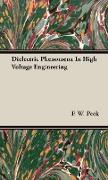- Start
- Dielectric Phenomena in High Voltage Engineering
Dielectric Phenomena in High Voltage Engineering
Angebote / Angebote:
Originally published in 1915. PREFACE: It is the object of the author to give in this book the properties of gaseous, liquid and solid insulations, and methods of utilizing these properties to the best advantage in the problems of highvoltage engineering. Such problems require a knowledge, not only of the laws and mechanism of breakdown of dielectrics as determined by experiment, but also a simple working knowledge of the dielectric circuit. Methods that have proved useful in designing apparatus, transmission lines, insulators, bushings, etc., are discussed and illustrated by practical application. In addition, such subjects as the manner of making extensive engineering investigations and of reducing data, the measurement of high voltages, the effects of impulse and high-frequency voltages, methods of draw- ing dielectric fields, outline of modern theory, various dielectric phenomena, etc., are considered. In all cases where laws and discussions of dielectric phenomena are given, it has been thought best to accompany these with experimental data. Much original work is given, as well as reference to other in- vestigations. The authors extensive research was made possible by facilities afforded by the Consulting Engineering Department of the General Electric Company, for which acknowledgment is made. Thanks are due Mr. H. K. Humphrey, and others, who have greatly assisted in the experiments and calculations. SCHENECTADY, N. Y., April, 1915. Contents include: PAGE PREFACE v DIELECTRIC UNITS xi TABLE OF SYMBOLS , , xiii CHAPTER I INTRODUCTION. ..... v ... v General discussion of energy transfer Experimental plots of dielectric and magnetic fields Analogy between magnetic and dielectric fields Analogy with Hooke s Law. CHAPTER II THE DIELECTRIC FIELD AND DIELECTRIC CIRCUIT 8 Mathematical Consideration General treatment of the dielectric field and dielectric circuit with discussion of principles used Parallel planes Field between per- mittance, etc. Concentric cylinders Permittance or capacity flux density and gradient Parallel wires Principles used in superposition of fields determination of resultant fields equation of equipotential surfaces, lines of force and flux density permittance gradient and equigradient surfaces Concentric spheres Spheres Two small equal spheres, field of, and permittance two large equal spheres, gradient, permittance Conditions for spark-over and local breakdown or corona Collected formulae for common electrodes Combinations of dielectrics of different permittivities Dielectric flux refraction Dielectric in series Dielectric in multiple Flux control Imperfect electric elastivity or absorption in dielectrics dielectric hysteresis. CHAPTER III VISUAL CORONA 38 General Summary and Discussion Appearance Chemical action A. C. and D. C. spacing and size of conductor Laws of visual corona formation Theory of corona Electron theory Air films at small spacings Aii density Measuring voltage by corona Conductor material, cables, oil and water on the conductors, humidity. lonization Wave shape, current in wire. Experimental Study and Method of Reducing Experimental Data Tests showing the effects of size and spacing of conductors Air density Temperature Barometric pressure Strength of air films Effect of frequency Conductor material, oil, water, dirt, humidity lonization Current in wire Stranded conductors Split conductors...
Folgt in ca. 15 Arbeitstagen
